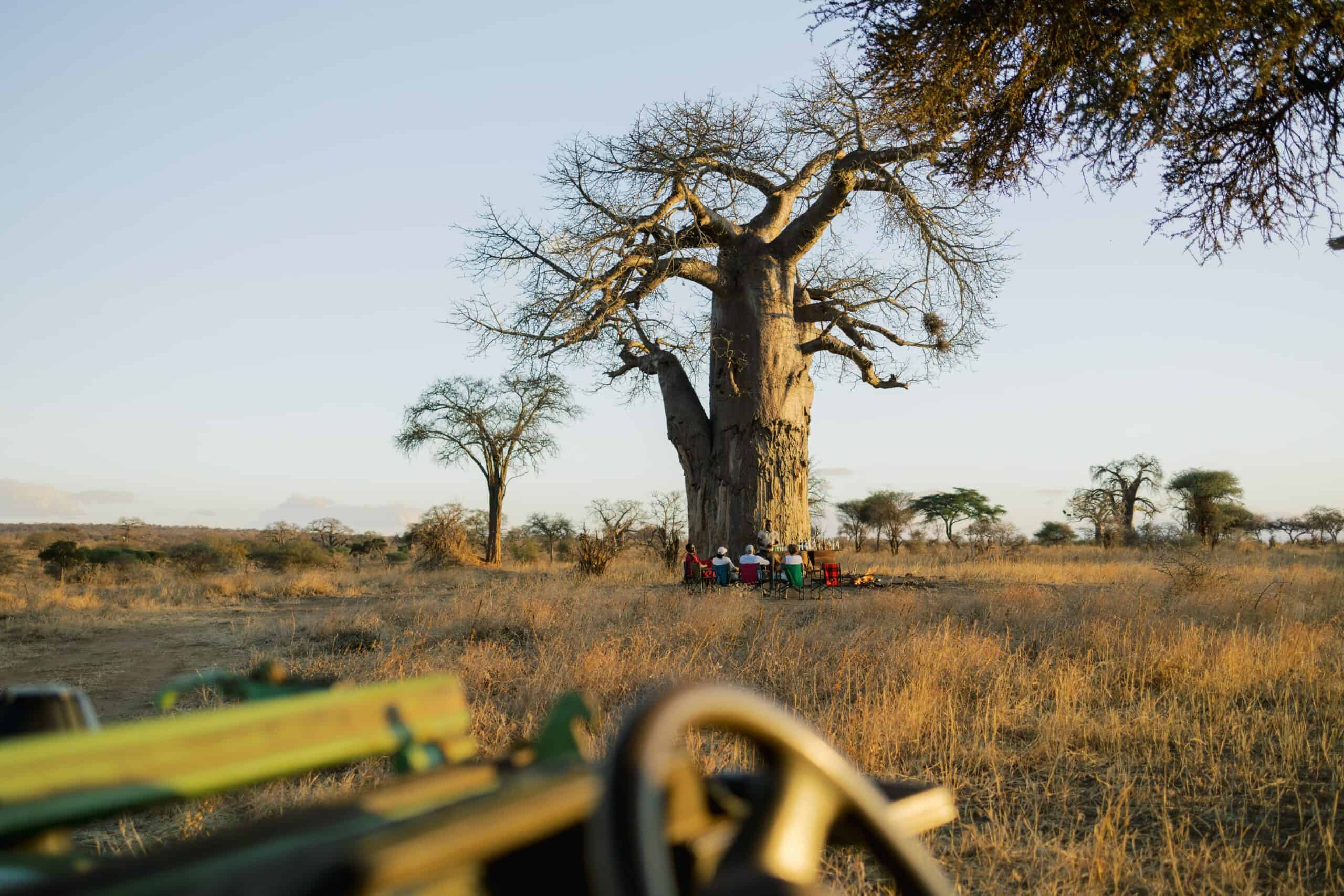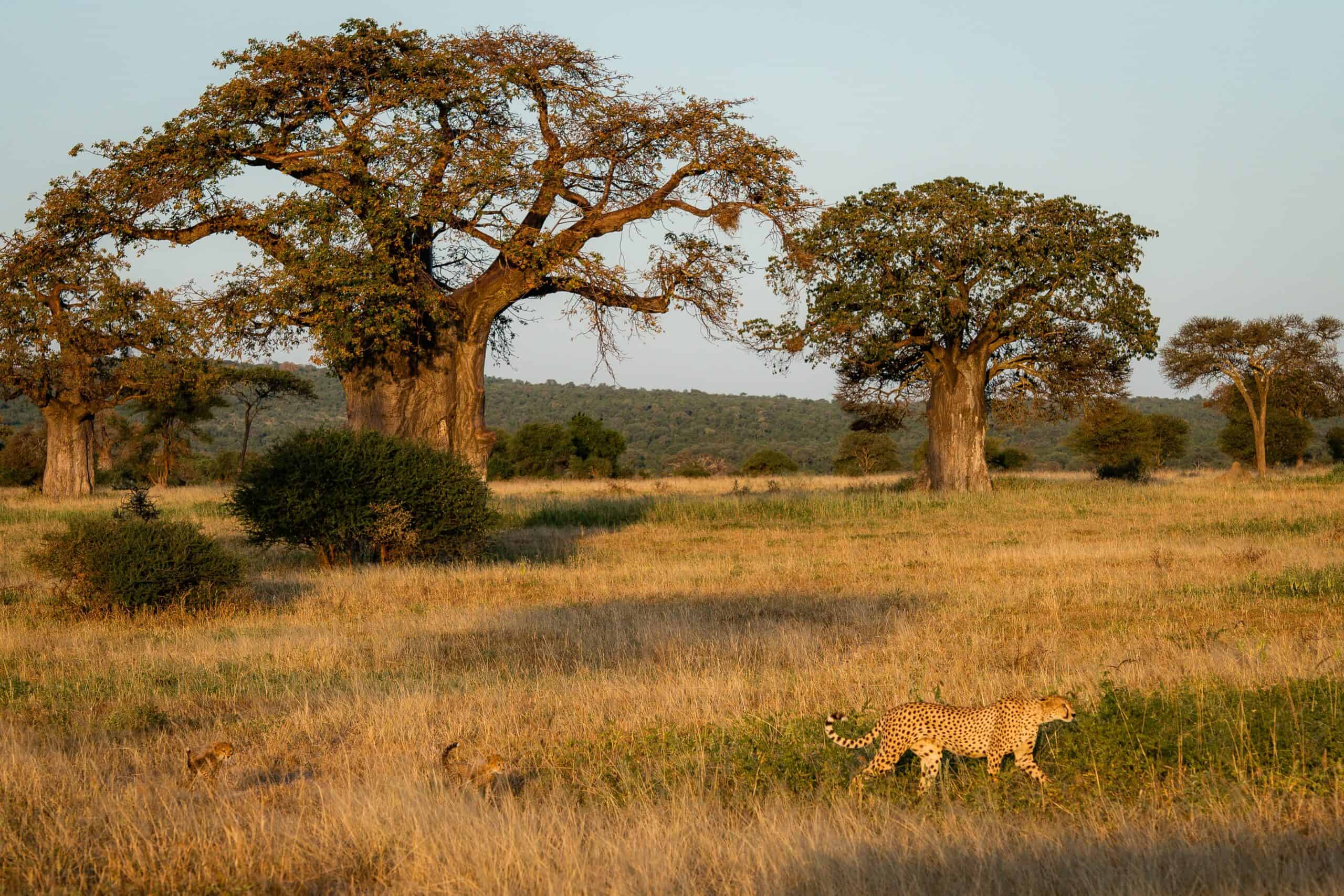
The African Baobab – Iconic Tree of Life
The African Baobab tree (Adansonia digitata) is one of the continent’s most iconic and recognisable trees. With its distinctive trunk and ability to provide shelter, food, and water to humans and wildlife, it has become a symbol of resilience and strength and has earned the name, the “Tree of Life”. This blog explores some interesting facts about the Baobab and its relationship with Elephants, Honey Bees, the Hadza people, and the surrounding ecosystem.

An Ancient, Living Food and Water Store
The most distinctive feature of the Baobab is its massive trunk which can measure up to 16 metres in circumference, making it one of the widest tree trunks in the world. The trunk is surprisingly soft and fibrous and stores up to 120,000 litres of water during the rainy season to survive dry spells. Interestingly, the bark is fire-resistant, making it a valuable resource for local people.
The Baobab is also known for its longevity, with some trees living for over 2,000 years, making them one of the oldest living organisms on the planet. A Baobab’s age can be estimated by measuring its circumference. Each year, the trunk grows a new layer of bark. However, accurate ageing will require radiocarbon dating.

A Wilderness Producer of a ‘Superfood’
Various animals, such as moths and beetles pollinate the Baobab. However, bats are responsible for pollinating up to 80 percent of its flowers.
The large white or cream-coloured flowers open at night and emit a strong, sweet scent to attract pollinators. Bats, particularly, are attracted to the fragrance and visit the flowers to feed on their nectar, and in so doing, transfer pollen from one flower to another.
Once pollinated, the flowers develop into large, woody fruit weighing up to 1.5kg, and containing hundreds of small seeds. The fruit has exceptional nutritional value and has been an essential source of food and medicine for many African cultures for centuries. It is rich in vitamin C, fibre, minerals, and antioxidants, making it a valuable addition to any diet.
In addition, some studies have shown that the Baobab fruit has more antioxidants than blueberries and pomegranates, making it a “superfood” in its own right.

Home, Hide and Larder for Many Species
The Baobab is an important nesting site for many bird species, including the Orange-bellied Parrot and various species of Hornbills. During the dry season, African Fish Eagles have been observed perching in wait for their prey to come to waterholes at the tree’s base.
In addition, antelopes, such as Kudus, can often be seen grazing on the leaves and bark, while Baboons and Vervet Monkeys consume the fruit. The monkeys have strong jaws to crack open the hard shell of the fruit to access the nutritious pulp inside. In turn, they are important for seed dispersal, as they swallow the seeds whole and deposit them elsewhere. Other bird species, such as the Yellow-necked Lovebird and the Bare-faced Go-away bird, are also known to eat the fruit and serve as important dispersers of seeds.
The Baobab has a special relationship with Elephants, which disperse seeds through eating the fruit and passing seeds through their digestive system. This process breaks down the seed’s tough outer shell, allowing it to germinate and grow. Elephants also use the Baobab as a water source during the dry season by breaking off branches and chewing on the bark to release the stored water within the trunk.
Baobabs play a vital role in the life cycle of African Honey Bees. The hollow trunks provide a perfect nesting site, offering protection from predators and the elements; and the nectar and pollen from its flowers are essential for producing honey – which is also highly prized by local communities, not only for its delicious taste but also its medicinal properties.


A Source of Food and Medicine for the Hadza People
The Baobab is an important cultural symbol for the hunter-gatherer Hadza people of northern Tanzania. Our own Entara fly camp in Lake Eyasi is named after it: “Om’bako”, meaning “a Baobab” in Hadzane, the language of the Hadza people. Baobabs dominate the Yaeda/Lake Eyasi landscape, which is home to the Hadza, who have used the Baobab for millennia as a food and medicine source, and as a gathering place for social and cultural events. In addition, ancient hollowed-out Baobabs are commonly used as temporary shelters.
The Hadza believe that the Baobab has remarkable healing properties and will often use it to treat various ailments. Honey is an essential food for the Hadza, who use pegs made of the Grewia Bicolor Bush to climb to the hives. They also eat the fruit and pound the seeds to make Baobab flour, which they mix into a porridge.


Learning from Baobabs
The African Baobab is a remarkable and iconic species with a rich cultural and ecological history. Its massive trunk, longevity, and relationships with people and wildlife make it a vital African ecosystem component. As we learn more about the Baobab and its intricate web of ecological inter-dependencies, we gain a deeper appreciation for its essential role in sustaining life in northern Tanzania and across Africa.






